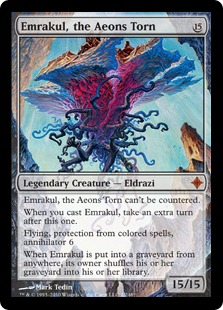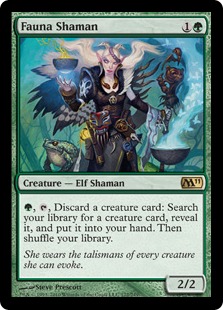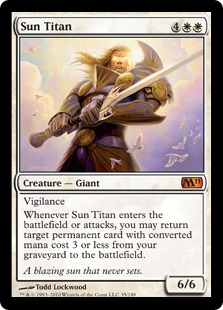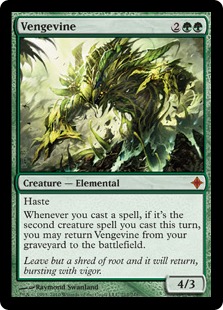2010 in Review: New Card of the Year
I have always enjoyed taking a look back at the cards released during the year. Evaluating cards before, during, and after their release is an important part of playing Magic. It lets you make informed decisions when buying, trading and selling, and when constructing decks. Trying to understand what cards you like, and why, is also useful in figuring out where you are as a Magic player, to put yourself in position to succeed at the game, and to enjoy it.
With all that in mind, what were my favorite cards in 2010?
This was a banner year for Magic, highlighted not just by huge tournament attendance and massive sales, but also by a large quantity of cards that were influential in Standard
and
Eternal formats. In terms of Magic design, this was one of the best years ever. I’ll try to prove this to you by going through a list of the new cards from 2010 — no reprints or functional reprints — that raised the bar this year.
I’ll take a look at all the candidates, and then reveal the winners.
Candidates — New Card of the Year, Expansions:
Arc Trail
While a completely fair card, it is also very good; Arc Trail is a good example of how R&D continues to redesign Lightning Bolt in ways that feel fresh and powerful.
Coralhelm Commander
Likely to be the card with Level Up that stays with us the longest, Commander is one of the best tribal lords in recent memory, and one of the few that functions perfectly as a standalone creature.
Devastating Summons
I think your enjoyment out of cards like this helps determine whether or not red decks are right for you. Summons is a deceptively deep card, strategically speaking — and it’s also massively powerful. I won a PTQ Standard game on turn 3 with Summons this year, so the card sticks out for me as one of my favorites. Goblin Guide into Goblin Bushwhacker kicked, into Summons where x=3,
plus
a second Goblin Bushwhacker kicked. Skill game.
Eldrazi Conscription
This makes the cut for me simply because I love that so many games were won with this crazy Aura.
Emrakul, the Aeons Torn
If I’m happy to see Conscription seeing play, you can imagine how much I love Emrakul. I actually got to resolve this guy the hard way a few times in Standard in 2010, in addition to cheating him out in Vintage and Legacy, and having him cheated out against me (which wasn’t as fun).
Everflowing Chalice
Scalable colorless mana acceleration? Yes, please!
Explore
Much like Squadron Hawk, I love how this card messes with our traditional metrics for evaluating cards and crunching numbers during deck construction.
Gideon Jura
A neat design on this Planeswalker — it has a very different feel than the other planeswalkers released to this point.
Kargan Dragonlord
My second-favorite Level Up creature, this is another “thinking man’s” red card.
Koth of the Hammer
You may have noticed that I like red cards. I like this red card, even if it is slightly underpowered in a format dominated by Jace, the Mind Sculptor and Primeval Titan. In fact, the very notion that Koth is “underpowered” is indicative of power creep issues, if you ask me.
Loam Lion
I played this over Kird Ape. What else is there to say?
Lodestone Golem
Don’t believe the haters! This card single-handedly changed the face of Mishra’s Workshop-based deck designs, and has catapulted that deck to a power level not seen since Trinisphere was unleashed.
Memnite
A seemingly innocuous free card that is part of turbo-charging Legacy Affinity as well as an enabler for the Quest decks in Standard and various combo decks in Legacy.
Mimic Vat
Have you resolved this yet? I
know
, right?
Molten-Tail Masticore
Have you resolved
this
guy?
I KNOW!
Mox Opal
While Mox Opal hasn’t caught on yet in most formats, I can almost guarantee that it will. At some point, this card will see play in competitive Legacy decks, and will probably see play in competitive Vintage also. Whether or not it becomes viable in Standard depends heavily on the rest of the Scars expansions…. but I suspect there will be Extended decks that will play it as well, given an entire block of artifacts plus three more blocks. This card is really undervalued at the moment, which for me, helps show how well-designed it really is.
Myr Battlesphere
A sleeper card for Vintage, and very good against Workshops. Should probably see more play than it does.
Nature’s Claim
It is hard for me to explain how much impact Nature’s Claim has had on my year in Vintage. It had a massively negative influence on Oath of Druids and Two-Card Monte, but bolstered Dredge throughout the year. You win some, you lose some.
Ratchet Bomb
This card is criminally underplayed in basically every single constructed format.
Sea Gate Oracle
Cards like this one are always, always popular. It is amazing how much value we place on a big-butt creature that lets us see a few cards. Also see: Wall of Omens.
Searing Blaze
I like red! Deal with it!
This is a much better Lash Out.
Smoldering Spires
Another tricky red card. I said “red card,” and I meant it.
Spikeshot Elder
Another sneaky red card that I think will get better, and see more play, once we find a better home for it.
Steel Hellkite
Rawr! Look at that thing! This is where I say
I told you so
.
“Dear Vintage players: I told you so. Love, Elias.”
There.
Stoneforge Mystic
Kind of like a rare Trinket Mage, Mystic will get better as Equipment gets better, etc.
Sword of Body and Mind
I majorly underestimated this card when it was spoiled. It is really powerful, probably underplayed, and tremendously well-designed.
Tectonic Edge
I would not have guessed this would be so omnipresent in Standard control decks.
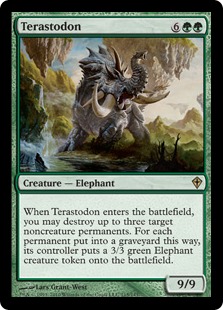
Terastodon
Lots of credit to Rich Shay for unleashing the Don on Vintage in February 2010.
Vengevine
Probably the Mythic rare that was called correctly by the Magic community at large. No matter how you look at Vengevine, it is an incredibly powerful card with reach all the way back into Eternal formats. Responsible for the banning of Survival of the Fittest.
Venser, the Sojourner
I really like this card and hope it sees more play. I’m not sure it is well-designed as a self-contained “story” or whatever, but the sum total of abilities results in a pretty awesome card.
Wall of Omens
Big butt, seeing cards, etc.
Wurmcoil Engine
Awesome design, great art, playable in Standard, Extended, and Vintage… Plus, for a Mythic, it has a reasonable real-world cost. Well done.
Candidates — Card of the Year, Core Sets:
Autumn’s Veil
Nice to see R&D continuing to push the envelope on color hosers that are narrower than Pyroblast / Hydroblast, but still playable. This one is actually better than you’d think from the minimal play it has received.
Brittle Effigy
One of the best — if not
the
best — artifact removal cards ever printed.
Fauna Shaman
It’s also great to see that creature strategies can be pushed without resorting to just making the creatures beefier and with more insane abilities. Baneslayer Angel and the Titans, I’m looking at you. Thank goodness this wasn’t Mythic.
Frost Titan
Massively underrated upon release, this card feels overwhelmingly blue.
Grave Titan
This is my favorite Titan. I love zombie tokens. This one also has really cool art.
Brains…
Leyline of Sanctity
One of the most sublime cards of 2010. Introducing a cycle of Leylines in a core set was a bold move, and one that I think was well-received. This Leyline had immediately obvious applications in Eternal formats, but has become a definitive sideboard card in Standard as well.
Preordain
Preordain was another card that was immediately pegged as Vintage fodder. Instead, it’s proven itself to be a staple in all legal formats.
Primeval Titan
Another Mythic pegged accurately by basically everyone, this is one of the most powerful creatures for Standard in recent memory.
Pyretic Ritual
I’m just surprised that this was snuck into a core set; this ritual has the subtle effect of letting One-Land Belcher have critical red ritual density in Legacy.
Squadron Hawk
I love this card, because it really messes with our understanding of the value of a single card, how card advantage functions, what it means to have a card that represents four cards when it resolves initially, and so on.
Sun Titan
A lot of people tried to shoehorn this creature into existing Vintage decks, but
Matt Sperling version of Oath
built around the card is one of the cooler decks of 2010; adding Pernicious Deed to his version really makes things interesting. I’m not sure we’ve explored this card enough in Standard.
My Top 10 New Cards of 2010:
This is not the “Most Powerful” or “Best” list in terms of use or performance in any specific format. It is, rather, the cards that I liked the most. These are the cards that I saw as broadly used and interesting for Magic overall, and as advancements in Magic design as a whole.
You have to keep in mind that as an Eternal player, I am going to undervalue cards that are here only for today’s Standard / Extended formats, and overvalue cards that I think will see play across formats over a long period of time.
Having said that, there is considerable overlap this year between the cards I liked, the cards that were most powerful across formats, and the cards that were best-designed.
10 — Leyline of Sanctity
9 — Fauna Shaman
7 — Primeval Titan
6 — Nature’s Claim
4 — Preordain
3 — Lodestone Golem
And the #1 new card of 2010 is…
1 — Vengevine
Why Vengevine?
It is one of the few cards that enables broken combos while also sitting at the top of the power level chart when judged on its non-combo, straightforward applications in Standard as well. While it was obvious that Vengevine was going to be very good,
how
good it actually was still surprised me.
I can’t go with Jace, the Mind Sculptor as number one because I had to read too many articles / posts / blogs / status updates about how it was destroying Magic, despite being the obvious best card of 2010.
Primeval Titan should maybe be higher, but I’m not sure the card has any life after Extended. Sinking $40 into cards that tank in value — yes, hello, Mr. Jura — always irks me.
While I didn’t mention them anywhere, I also like the design of the new Scars dual cycles. A hearty “well done” to whoever came up with those!
The Two Decks I Made in 2010 That Didn’t Suck
Over the course of 2010, I felt like I built the right deck for a tournament a whopping two times, which is actually still a decent batting average.
Let’s look at the obvious one first:
Creatures (23)
- 3 Grim Lavamancer
- 4 Tarmogoyf
- 4 Wild Nacatl
- 3 Knight of the Reliquary
- 4 Qasali Pridemage
- 3 Steppe Lynx
- 2 Loam Lion
Lands (21)
Spells (16)

Was the sideboard of this deck correct? Probably not, in that I used only five of the fifteen cards in it during the tournament. However, that meant that I was playing against the matchups I wanted to see when I chose Zoo before the tournament started… And ultimately that was what mattered. I got lucky in one of the three mirror matches and was able to use that to get me all the way home.
The most important things about this deck were that I assigned huge value to Steppe Lynx and Price of Progress, two cards not widely used at that point, and built with them and around them; I also cut cards like Sylvan Library that were considered by many to be “sacred cows” and ran a rather different sideboard than most people would have.
There’s a lot of overly simple lessons there, like “trust your testing,” “play what you know and what you like,” and so on… but
I already wrote that article
.
The other deck that didn’t suck?
Creatures (22)
- 2 Ichorid
- 1 Flame-Kin Zealot
- 4 Golgari Grave-Troll
- 2 Golgari Thug
- 4 Stinkweed Imp
- 4 Narcomoeba
- 1 Woodfall Primus
- 4 Bloodghast
Lands (13)
Spells (25)
- 4 Cabal Therapy
- 4 Serum Powder
- 4 Chalice of the Void
- 1 Darkblast
- 4 Leyline of the Void
- 2 Dread Return
- 4 Bridge from Below
- 2 Nature's Claim
Sideboard

I wrote a tournament report on this deck
— and while I didn’t win that tournament, this deck is probably the thing I did during 2010 that had the most impact on other Magic players, in terms of deckbuilding.
While the sideboard often looks a little different, due to the printing of Leyline of Sanctity and the sometimes-use of Serenity, the majority of Vintage Dredge decks not played by Jake Gans that you see in top 8s during the entirety of 2010 are based on this design…. which is itself based on decks I saw doing well in Manila.
This is notable in that only three months prior, no less than three different Dredge decks were all being played and all were putting up results. Very quickly, most players seem to have adopted this style over the others.
How do you know a Dredge deck based on this design?
First, you’ll see four Bloodghasts and either two or three Ichorids (and often will find one moved to the sideboard), along with two Petrified Fields. This is to allow the deck to grind out games against Workshops and to add resiliency. Undiscovered Paradise will be used to fuel Bloodghast.
Second, beyond Cabal Therapy, you’ll find a package of eight disruption cards that are almost always Leyline of the Void and Chalice of the Void. These allow you to disrupt other Dredge decks, and decks seeking to utilize Yawgmoth’s Will. Sometimes Leyline of Sanctity will be swapped into the maindeck for Leyline of the Void.
Third, you’ll see two Dread Returns with two targets — typically one Flame-Kin Zealot and one disruptive creature, usually either Terastodon, Angel of Despair, Woodfall Primus, or Iona, Shield of Emeria.
Fourth, you’ll find twelve Dredge cards, often including either two Golgari Thug, one Dakmor Salvage, and one Darkblast, or two Thug and two Dakmor Salvages.
Fifth, you will see Serum Powder, and two or three cards devoted to beating maindeck Leyline of the Void and/or racing Time Vault — typically Nature’s Claims.
Despite the fact that Dredge sees far less play than Workshop or Mana Drain strategies, and generally makes up only 5-10% of the field, or less, in many tournaments, it has put up
tremendous
results throughout the year. I put this version together based on notes I had from prior events and thoughts on the metagame, but I never expected to see the deck win over and over and over again throughout the entire year.
Obviously if I had, I’d have named it Elias Dredge…
Best Magic Set of 2010:
It has to be Rise of the Eldrazi. I liked the Limited format, there were a lot of great cards that were immediately influential in a range of formats, and it turbo-charged that block format into one of my all-time favorites. The set as a whole was exceptionally flavorful. I didn’t think a set designed around giant, colorless creatures could possibly be any good, but I’m glad I was wrong.
My runner-up would probably be M11, which has to be in the conversation for best Core set of all time.
Blunders of the Year
Jace, the Mind Sculptor
Did I enjoy playing Jace in Vintage during 2010? Sure, almost any time it resolves, you get to do all kinds of crazy things. That said, it
is
rather annoying to have yet another blowout card that Vintage decks can resolve as quickly as turn 1. It also doesn’t seem right that the most expensive Standard card (and most expensive since, um… well, possibly ever, actually), is such a cornerstone card of the format and so critical to so many decks.
Jace clearly isn’t a crippling error, or ruinous to Magic, in that the card is well-designed (if totally broken), fun to play with as long as you’re the one that has it in play, and certainly is beatable. But having a card like this that is so expensive and so necessary did create a lot of ill will among the player base.
Kor Firewalker
Booooooooo!!!!! I mean, I get it — red was really powerful this year — but so much of that power, and what could have been a budget foil to Jace decks, was ruined by the fact that you could not beat Kor Firewalker for a good chunk of the year. As color hosers go, this just seems too strong to me. Why not just reprint Dystopia while you’re at it?
Underperformers of the Year
Abyssal Persecutor
Finally involved in some decent decks at the back-end of 2010, Abyssal Persecutor was always a nice niche card, but was definitely overvalued when first spoiled.
Momentous Fall
I had such high hopes for this card, and it lets you do some really cool things, but the situations where you want it don’t seem to exist in this Standard format. Put another way, it’s hard to be in green and want to look for incremental value during 2010, when you can play decks like Mythic and Valakut.
Realms Uncharted
We probably should’ve seen this one coming. What was really so exciting here, anyway?
Sarkhan the Mad
I like the design of this card a lot, but Sarkhan saw only niche play throughout the year.
See Beyond
Some were really excited by this card in Eternal formats. It just isn’t good enough; a nice card, a neat card, just not enough to get it done.
Thada Adel, Acquisitor
This one seemed so very exciting in Vintage, but as Time Vault fell off to some extent, Thada never made much of a splash.
Time Reversal
I didn’t think this would drop below $5. I was wrong.
Treasure Hunt
Similar to See Beyond, this is a fine card that just isn’t right for
this
Standard format.
Let’s not stop there. More lists!
Videogame of the Year: Fallout: New Vegas
Generally, my pick for videogame of the year will either be my favorite FPS of the year, or a Bethesda RPG. Unfortunately for the many competent FPS console games of 2010 (including Halo: Reach, and Call of Duty: Black Ops), Fallout: New Vegas released this year.
Detractors will say that Fallout: New Vegas is simply an expansion pack for Fallout 3 — and in many ways, it is. The core of the game is an upgraded version of the same platform that powered Fallout 3, but the updates bring so much depth to the game that it
feels
different, fundamentally, than Fallout 3 did.
Fallout 3 was black and white: Enclave, bad! Fallout: New Vegas is many shades of grey. Nobody is truly good, and few are truly evil. In this game, Karma isn’t really that important. Instead, various towns and factions measure you independently, although your affiliations or allegiance with one faction will affect your relations with another. This adds all types of new wrinkles to the game play, as well as providing motivation for replay that wasn’t present in Fallout 3.
Some minor changes in New Vegas include a higher level cap out of the box, and an adjustment to leveling perks (every two level-ups instead of every one, which makes choosing one feel more important). They also made several significant game play tweaks.
For one, targeting in VATS isn’t as powerful as it was in Fallout 3. At higher levels in Fallout 3, where you could get various VATS bonuses and Action Point bonuses, VATS made your character a nigh-invincible, high-precision killing machine. Relatively early in Fallout 3, in terms of time investment, you were able to use high-powered weapons and wear power armor. In Fallout: New Vegas, I found that given the option of a weaker VATS and a variety of low-power rifles, I would prefer to run around bashing things with a tire iron. Weapon, Armor, and VATS strength power up slower in New Vegas — but once I got used to it, I found that I enjoyed the game more; the ability to aim down a weapon site also helps make up for a weaker VATS.
The other key difference is in the more robust companion and follower system. In Fallout 3, you were able to have one companion as well as a dog. By far the most useful companion was Fawkes, who had about a billion hit points and carried insane weaponry. In New Vegas, the ability to manage your team has improved drastically as you are able to have two teammates, a follower and a companion, and speaking to them opens a command wheel, where you can discuss tactics (stay close, stay far away; use melee, use ranged; be aggressive, be passive; and so on) and trade equipment. Using companions effectively adds a lot to the game. When I found a mix I liked, I really felt less like I was a lone wanderer and more like I had a group of characters like you find in many other console RPGs.
Not everything in Fallout: New Vegas is improved, however. The frame-rate seems to “chug” more often than it did in Fallout 3, as if the engine buckles under the weight of additional companions. The game also shipped with a lot of game-destroying bugs, glitches, and freezes. Some of these required players to do a complete restart.
One trick with Bethesda games, folks: don’t start playing them upon release, wait until the first patch is put through. Thank me later.
I experienced corrupted auto-saves on a few occasions, which didn’t happen to me in Fallout 3, and also got “stuck” more than once in the game world and had to reload. However, I found the game straight-up crashed less often than Fallout 3 did, although I’m playing on a new console and can’t be sure how much of the game freezing was related to the console itself. Less important, I found the radio music in New Vegas to be inferior to Fallout 3, with less of a song selection. The actual music itself grew on me a lot as the game progressed, but it also got really repetitive.
All in all, though, Fallout: New Vegas is easily my game of the year. The story presents a moral / ethical depth not normally experienced in console RPGs, while the game maintains (and in many instances, improves upon) the Fallout experience, inclusive of some great humor and sight gags.
Runner-Up: Red Dead Redemption
Red Dead Redemption is a terrific game that I have shelved while I engage in my love of all things Fallout. It has one of the better downloadable add-ons of any console game in recent memory. There’s something about the Western done right that explains why that setting has been so indelible in film and print over the years. I think this is Rockstar’s best game yet, and it delivers on a lot of the innovation and promise of GTA III, perhaps even more than GTA IV did.
Honorable Mention: Limbo (XBLA)
The last game I played that had the ambiance of Limbo — a type of haunting, fairy-tale mood that stays with you even after you put the game down — was Shadow of the Colossus, which is one of my favorite games ever. Limbo isn’t
quite
on that same level, but it is a subtle and instant classic. The fact that it is an Xbox Live Arcade release blew my mind, because as a game experience, it was significantly better than most full-price store releases for the major consoles in 2010.
Xbox 360 — Kinect
Whether or not Kinect is successful will be directly determined by the software that uses it — but the technology itself is impressive. There are areas where it is significantly better than the Wii or PS Move technology, as it measures your entire body in space and maps all your movements. Thus, a game like Dance Central will always be better than some similar product on the other consoles… and similarly, Kinect Bowling is far cooler than Wii Sports could ever be.
Still, the lack of actual “buttons” is a limiting factor in many ways — one that I hope can be mitigated by use of Kinect’s voice command system, which is sadly limited in use at the moment.
To show you how much my mind defaults to thinking about Magic, the very first thought I had when I got my Kinect working was, “This would make the best Magic Online platform of all time!”
Magic is a game you control with your hands. You can maneuver through the Kinect menu system like Tom Cruise in Minority Report. You could very easily build an in-game platform for playing Magic that mirrored actually playing Magic in most respects and was controlled via your hands with no button input.
Deck construction would be annoying with such a system, but even this is easily fixed with voice control. How awesome would it be to control your Magic inventory by voice command?
“Add four Jace, the Mind Sculptor…”
Xbox 360 is already an online platform. Sadly there is no exact replica on PC at the moment, but it would be so awesome to have an Magic Online experience that closely mirrored the real-life experience instead of the one we have now.
Album of the year: Arcade Fire, Suburbs
I was convinced this was going to be a letdown, but I couldn’t have been more wrong. I actually think this is growing into one of my favorite albums ever, period.
Not much else to say about that, so here’s something fun…
Favorite pre-Tournament Playlist of 2010
This is the playlist I settled on early in 2010, and for some reason I seemed to do very well in tournaments where listened to this all the way through before and/or during tournaments.
-
Bring the Pain
, Method Man -
Archers
, Brand New -
The Rat
, The Walkmen -
Walk Idiot Walk
, The Hives -
Bone House
, The Dead Weather -
Wolf Like Me
, TV on the Radio -
I Know What I Am
, Band of Skulls -
You Know You’re Right
, Nirvana -
Black Math
, The White Stripes -
Bleed Black
, AFI -
Know Your Enemy
, Rage Against the Machine -
Release Yo’ Self
, Method Man
Lastly…
I wanted to thank some folks:
My wife, for supporting me and putting up with the fact that I invest so much time into this game, and my parents for doing the same so many years ago.
My dogs, for being awesome.
StarCityGames.com, for expanding an already awesome tournament series, and for giving me a platform to get my ideas out there.
The Vintage and Legacy communities, for being supportive of my writing. Thanks for reading.
Nick Coss, Alternate Universe — Blue Bell, and everyone else who plays at the Blue Bell Vintage tournaments, for being part of the most vibrant and competitive Vintage tournaments in the United States.
Wishing you all a safe and happy new year,
Matt Elias
[email protected]
Voltron00x on SCG, TMD, and The Source

